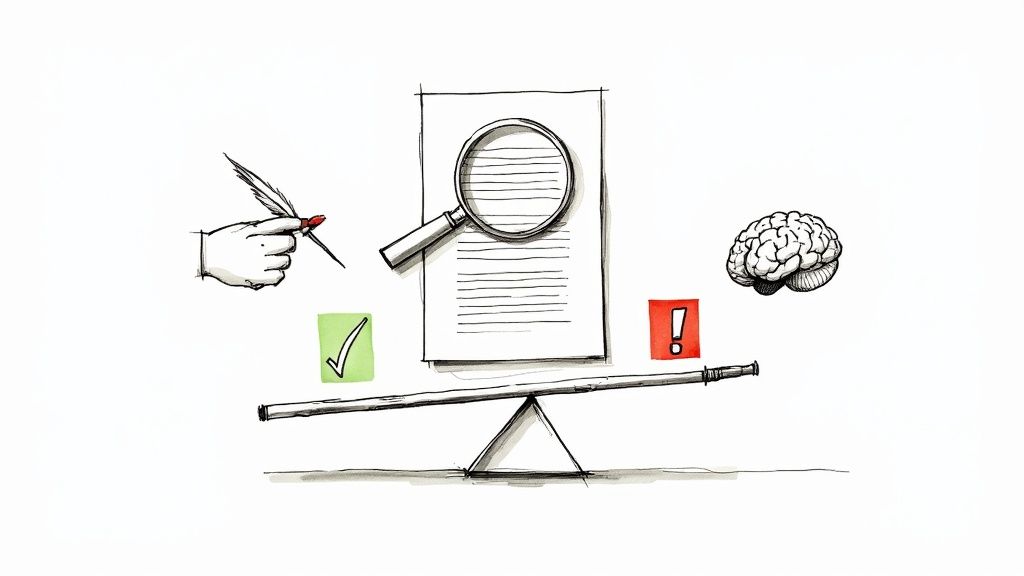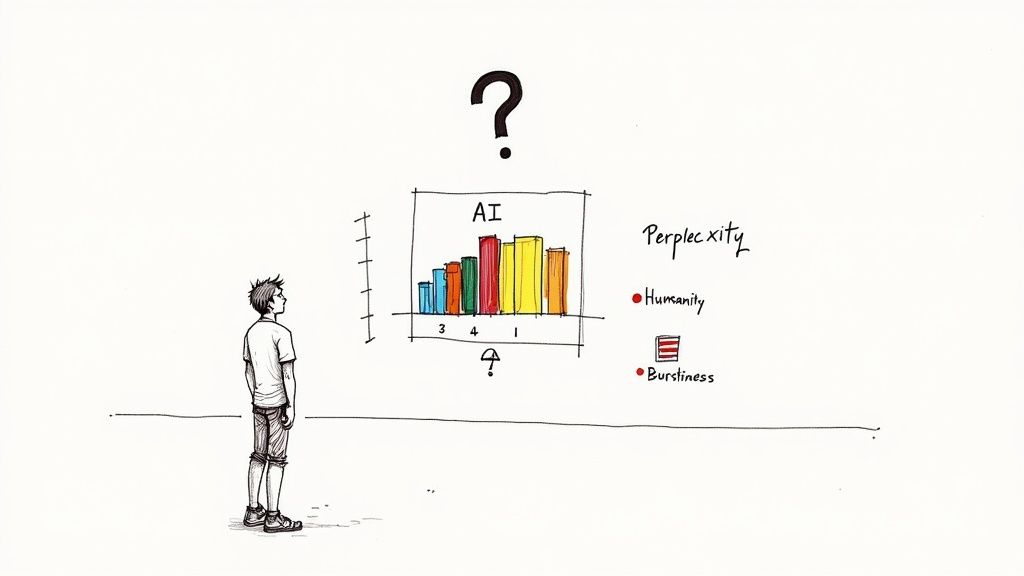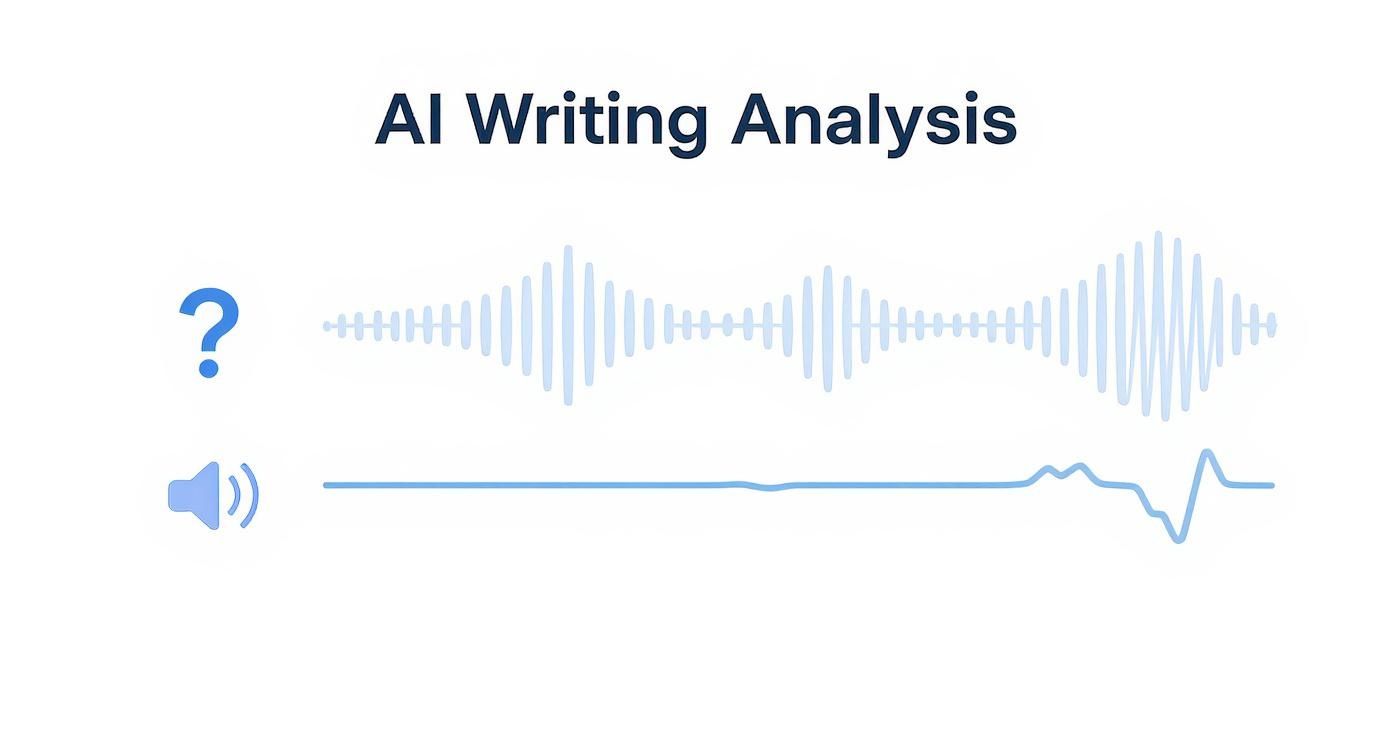Are AI Detectors Accurate? A Practical Guide for Content Creators

So, can you really trust an AI detector with your content? The honest answer is... it's complicated. As a content creator, marketer, or student, understanding their limitations is key. Their reliability varies wildly, making them less of an infallible judge and more of a helpful—but often flawed—first opinion.
Understanding How AI Detectors Work

You’ve likely been there. You finish a great blog post, run it through a checker, and get a confusing score. Worse, it might even flag your own original work as AI-generated, a frustratingly common scenario for writers today.
At its heart, an AI detector doesn't actually read your work for meaning. It’s a sophisticated pattern-spotter scanning for tiny linguistic giveaways—like a detective dusting for the fingerprints an AI model leaves behind.
The Key Concepts: Perplexity and Burstiness
These tools are trained to look for a few key signals. Understanding them is your first step to creating more authentic content.
- Perplexity: This is a measure of how predictable your writing is. Human writing is wonderfully messy and full of surprises—unique phrasing and odd word choices—which gives it high perplexity.
- Burstiness: Think of this as the rhythm of your sentences. You naturally vary your sentence structure, mixing long, flowing sentences with short, punchy ones. This creates a "bursty" texture that feels human.
Older AI models produced text that was too perfect and uniform, making it easy to spot. But as AI gets smarter, these lines are blurring, making detection a much tougher game for everyone.
For example, before it was shut down, OpenAI's own detector only correctly identified 26% of AI-written text. More concerning, it wrongly flagged 9% of human writing as AI-generated.
The crucial takeaway for any creator is this: An AI detection score is not a final verdict. It is a probability based on algorithms that can, and often do, get it wrong.
This is a big part of why we created PureWrite. Our goal isn't just to "beat" a detector. It's to give you the power to transform an AI-assisted draft into something genuinely authentic that truly sounds like you. For a deeper dive, this resource on Are AI Detectors Accurate is a great read.
AI Detector Accuracy At a Glance
To put it all together, here’s a quick summary of the key factors that impact how reliable these tools really are for you.
| Factor | Why It Matters for You | Your Actionable Takeaway |
|---|---|---|
| Model Sophistication | Newer AI models (like GPT-4) write in ways that are far more human-like, making them harder to detect. | A score might mean less if your starting draft came from a highly advanced AI. Focus on deep editing. |
| Text Length | Detectors are much less reliable on short texts. They need enough content to find meaningful patterns. | Don't trust a high AI score on a single paragraph. The tool is likely just guessing. |
| Human Editing | The more you edit and infuse your own voice, the more the statistical "fingerprints" of the AI fade. | Heavy editing is your best defense against false positives. Make the text your own. |
| Language & Topic | Detectors are often trained on English and common topics. They struggle with non-English text or niche subjects. | If you write for a specialized audience, the detector may be less accurate and more prone to errors. |
Ultimately, these tools are just one piece of the puzzle. They can offer a hint, but they should never be the final word on your content's authenticity.
The core technology behind these detectors is sophisticated pattern recognition, much like the systems used in other fields. For a great parallel, you can see how similar models operate in finance by reading about Machine Learning Fraud Detection Explained.
Knowing how this works is a game-changer for you as a writer. It explains why a heavily edited AI draft can pass as human. When you inject your own voice, tweak sentence structure, and add personal flair, you're essentially smudging the AI's original fingerprints.
This also sheds light on the incredibly frustrating problem of "false positives." If your natural writing style is very direct or follows a strict formula—common in technical guides—your work might have naturally low perplexity. In that case, you, a human, could accidentally write something that an algorithm flags as robotic.
This is exactly where a tool like PureWrite can help. We built it to help you take AI-assisted drafts and weave in the natural variation that makes content feel genuinely human. Try PureWrite today and see how it can help your authentic voice shine through.
The Real-World Accuracy of Popular AI Detectors
Marketing claims are one thing, but how do popular AI detectors actually perform for creators like you? The gap between advertised accuracy and real-world results can be massive. While many tools boast near-perfect detection, independent studies show a different story.
A huge part of the problem is the constant cat-and-mouse game. The AI model used to write the text—say, GPT-3.5 versus the more sophisticated GPT-4—can completely throw off a detector's accuracy. As AI writing gets more nuanced, the detectors are always playing catch-up.
The Looming Threat of False Positives
For any writer, the biggest fear is the "false positive"—that sinking feeling when your own work gets flagged as AI-generated. This isn't just a small hiccup; it can have serious consequences for students, professionals, and marketers facing unfair accusations based on a flawed algorithmic guess.
Consider Turnitin, a giant in the academic space. It launched its AI detector claiming 98% accuracy. While about 11% of the 200 million papers it scanned showed significant AI writing, real-world tests reveal a false positive rate of around 4% at the sentence level. That means thousands of students could be wrongly flagged. You can dive deeper into Turnitin's detection capabilities in our detailed guide.
This infographic breaks down the two core concepts—perplexity and burstiness—that these tools use to make a judgment call.

Once you understand these metrics, you can see why even your own human writing can sometimes trigger a detector, especially if the style is very consistent or predictable.
So, How Accurate Are They, Really?
The short answer? It's complicated. When you look at advertised numbers versus what independent tests find, a different picture emerges for you.
AI Detector Performance Comparison
| Detector Tool | Advertised Accuracy | Observed False Positive Rate | Your Best Use Case |
|---|---|---|---|
| Turnitin | Claims 98% overall | ~4% (at sentence level) | Initial screening in academic settings |
| Originality.ai | Claims 99% on GPT-4 | Ranges from 2% to over 8% | Checking for both AI and plagiarism in SEO content |
| Copyleaks | States "over 99% accuracy" | 10%-15% in some studies | Identifying AI in mixed human-AI texts |
| GPTZero | Claims 99% on human text | Up to 20% on creative writing | Quick, accessible checks for educators and writers |
As you can see, real-world performance often doesn't live up to the marketing hype. These tools can be a helpful first pass, but they're far from infallible.
What to Expect and How to Move Forward
The accuracy of an AI detector is never static. It fluctuates based on the text's complexity, the AI model it's compared against, and any human editing you've done. So, are they accurate enough to be the final judge of your work's authenticity? The evidence points to a firm no.
Treat AI detection scores as a preliminary signal, not a definitive verdict. They offer useful insights but lack the contextual understanding to be completely reliable.
For writers who use AI to get a first draft down, this is a crucial distinction. The goal should never be to just "trick" a detector. Instead, your focus should be on an ethical workflow that combines AI's speed with your unique expertise and voice. You can use some of the best content optimization tools to help with this process.
This is exactly where we believe PureWrite can change the game for you. We help you take a functional AI draft and transform it into a polished piece that is genuinely yours, adding the human fingerprints that create authentic, high-quality content.
Ready to make your content undeniably human? Try PureWrite today.
Why AI Detectors Flag Human Writing

It’s an incredibly frustrating moment for any writer: you spend hours crafting a piece from scratch, only to have an AI detector slap a "machine-generated" label on it. This "false positive" happens more than you might think, and it's essential to understand why it occurs to protect your work.
The root of the problem is that these tools don't understand your content. They just hunt for patterns. If your natural writing style happens to share characteristics they associate with AI, you get flagged. It's not a critique of your writing; it's a blind spot in their design.
Common Triggers for False Positives
So, what kind of human writing looks "robotic" to a machine? A few common habits can accidentally set off the alarms. Knowing them is the first step to avoiding them in your own work.
- Formulaic Writing: When you're creating highly structured content—like technical manuals or step-by-step guides—your writing can lack the organic variation detectors expect from a human. A predictable flow can look suspiciously clean to an algorithm.
- Over-Editing with Tools: Grammar checkers and style guides are great, but they can be a double-edged sword. Relying on them too heavily can smooth out the unique quirks and personal touches that make your writing sound like you, leaving a text that seems too perfect.
- Predictable Vocabulary: Sticking to common phrases can lower your text's "perplexity." Simpler, more predictable text sometimes looks like it was created by an older, less sophisticated AI model.
Non-Native Speakers Are Disproportionately Affected
There's another serious flaw: a built-in bias against non-native English speakers. Writers still learning the nuances of English often use more standard sentence structures and vocabulary.
While their writing is perfectly clear, this predictability is often misinterpreted by AI detectors. This unfairly penalizes writers who are simply trying to communicate effectively, flagging their work at a much higher rate. A 2023 Stanford study found that detectors were up to 20 times more likely to flag text from non-native English speakers.
At PureWrite, we believe your authentic voice should never be penalized. Learning what is tone in writing and how to weave it through your work is crucial. Our tool is built to help you refine your text, adding the natural rhythm and stylistic flair that proves its authenticity. Try PureWrite to ensure your hard work gets the credit it deserves.
A Practical Framework for Ethical AI-Assisted Writing
Using an AI writing partner is a smart move for any creator, but letting it run the show can lead to generic, low-quality content. The sweet spot is blending AI's speed with your human creativity and critical oversight. This framework is all about starting with AI but finishing with a human touch.
Use your tool for the heavy lifting—like brainstorming or creating a first draft. After that, it’s your turn to step in. This is where you weave in personal stories, unique insights, and the distinct voice that makes your writing yours. The goal isn’t just to avoid detection; it’s to create something genuinely valuable.
From AI Draft to Human Masterpiece: Your Workflow
Think of your AI tool as a capable co-pilot; you're still flying the plane. Once you have that initial draft, the real work of writing begins. Here’s a practical workflow you can put into action today.
- Fact-Check Everything: AI models can "hallucinate" or present outdated information as fact. Your credibility is on the line, so you must verify every claim and source before you publish. For example, a marketer using AI to draft a case study must manually verify all client data and quotes.
- Rewrite for Voice and Variety: AI writing often falls into a repetitive rhythm. Actively rewrite sentences, varying their length and structure. This is how you infuse your personal tone and break up the monotonous cadence that detectors are trained to spot.
- Inject Your Experience: Share a personal story or offer an opinion backed by your expertise. A student writing an essay, for instance, can use AI for research but must add their own critical analysis and interpretation to make the work truly original.
Why Authenticity Always Wins
At the end of the day, authenticity connects with both human readers and search engines. A recent academic study on detector accuracy revealed a massive gap: real, published articles scored very low for AI likelihood (between 5.88% and 27.55%), while raw AI content scored a whopping 99.6%. You can learn more about these academic findings to see the difference for yourself.
This data is exactly why a hands-on, human-first approach is non-negotiable. For a deeper dive into building a responsible AI process, check out our guide on ethical AI usage in writing.
The best content feels like it was written by a person, for a person. AI can help you start, but your unique human perspective is what makes it memorable.
For that crucial final polish, a tool like PureWrite can be a game-changer. We help you refine AI-assisted drafts, smoothing out awkward phrasing and enhancing the natural flow. This ensures your final piece isn't just undetectable—it's exceptional.
Ready to transform your AI drafts into authentic, high-quality content? Try PureWrite today.
Moving Beyond Detection Toward Authentic Content
The "are AI detectors accurate?" debate can be a distraction. The real challenge for you isn't about fooling software; it’s about creating genuinely good content that connects with people.
Let's be honest, both search engines and human readers are getting smarter. They look for content that shows real expertise, experience, authority, and trustworthiness (E-E-A-T). Churning out generic text won't cut it if you want to build an audience that trusts you.
Focus on Value, Not Just Volume
Your North Star should always be delivering real value to your reader. Think of AI as a capable assistant that supercharges your unique perspective, not as a replacement for your expertise.
Here's how that works in practice for you:
- Beat writer's block: Use AI to brainstorm initial ideas or rough outlines when you're staring at a blank page.
- Speed up research: Let it gather background info so you can spend your time on analysis and interpretation.
- Free up your creativity: With tedious tasks handled, you have more mental space for strategic thinking and telling a great story.
This way, you keep your hands firmly on the creative wheel while getting a major efficiency boost. For more hands-on tips, we have a whole guide on how to effectively humanize AI text.
The smartest creators get it: AI is a tool to amplify human creativity, not a shortcut to replace it. A real connection comes from genuine insight and a voice that's truly yours.
That’s what we’re all about at PureWrite. Our mission is to help you take a sterile, machine-generated draft and transform it into something compelling that speaks to your audience. We help you refine the tone and inject your unique style, ensuring your work is both authentic and impactful.
Ready to stop playing the detection game and start creating better content? Give PureWrite a try and see the difference for yourself.
Your Questions About AI Detector Accuracy, Answered
If you're a writer, you've probably got questions about AI detectors. It's totally normal to wonder what their scores really mean for your work. Let's tackle some of your biggest concerns head-on.
Can AI Detectors Actually Be 100% Accurate?
In a word: no. 100% accuracy is not possible for any AI detection tool. These tools work by identifying patterns and calculating probabilities, not by reaching absolute certainty. This means there's always a chance for error.
You'll run into two types of mistakes: false positives, where they mistakenly flag your own writing as AI-generated, and false negatives, where they completely miss text that came from an AI. Think of a detector's score as an educated guess—one piece of data, but never the final word.
Can Paraphrasing Tools Trick AI Detectors?
Sometimes, but it's a risky and unreliable strategy. A basic paraphrasing tool might shuffle words enough to fool a simple detector, but more advanced detectors are trained to spot the underlying fingerprints that AI models leave behind, even after a rewrite.
And let’s be honest, leaning too heavily on paraphrasers often backfires. You might end up with text that's technically "undetectable" but has been stripped of its original meaning, nuance, and personality. The result is often clunky, robotic, and unreadable.
Is It Wrong to Use AI to Help with Writing?
Not at all. The ethics of using AI in your writing boils down to how you're using it and whether you're being transparent. Using an AI as a brainstorming buddy, an outliner, or a tool to get past writer's block is a smart way to work more efficiently.
Where you cross an ethical line is when you pass off AI-generated text as your own original work, especially in academic or professional settings where authenticity is required. The golden rule is transparency. Always use AI to enhance your own skills, not to fake your human insight.
Here at PureWrite, we're all about helping creators like you use AI the right way—ethically and effectively. Our tool is built to help you take that AI-assisted first draft and turn it into a polished, authentic piece that truly sounds like you. Instead of trying to "beat the detector," focus on elevating your content to a level that is undeniably, powerfully human.
Give PureWrite a try and see what a difference it makes.